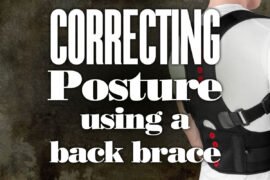Psychosocial factors such as mental strain and stress caused by work are also factors in poor posture. People who have higher levels of stress in their work are more inclined to develop neck and shoulder strain that is related to poor posture.
Posture is defined as how you hold your position and body and it is essential for breathing, spinal health and overall well-being. In fact, having good or bad posture can impact a person’s health in so many ways.
Bad posture can cause different aches and pains, migraines, temporomandibular joint (TMJ) dysfunction, and more.
When one has good posture, it can be said that the person is fit. It means that the body’s muscles are able to support its skeleton in a stable alignment. It also makes it very efficient in movement.
Numerous factors in daily life can get in the way of good posture, unfortunately. Something as simple as dealing with gravity on a day-to-day basis can impact posture in a bad way.
For some people, poor posture can come from an injury, disease, or even genetics, which are things that are out of your control. Not many people are aware that they have poor posture, but many things can be done to fix poor posture once you’ve realized that you have it.
Medical treatment and lifestyle changes are helpful in fixing poor posture, but the best way to treat it is to have an awareness of the problem. For some, this means getting a diagnosis from a doctor and getting help from a physical therapist.
For others, knowing the reasons why they have poor posture helps a lot in knowing what step to take next such as getting a good back brace like the Royal Posture Back Support Brace, and doing exercises at home.
Since numerous factors can cause poor posture, in this article, we will discuss some of the possible reasons why your posture has deteriorated over time.
Fatigue: Causes of Bad Posture
Table of Contents
In order to have good posture, children are often told to stand up straight. It is true that keeping the back straight and tall is essential for good posture, but it is very difficult to hold that position for long periods of time.
Fatigue can eventually overcome the muscles that support the back and this may cause the spine and shoulders to sink lower thus worsening the posture. To counteract this, make sure that you do not stay in one position for long periods of time.
- Can motivate rest and relaxation
- Can improve sleep quality
- can cause long term harm to the body
- unhealthy and potentially dangerous for overall health and well-being
Age
 Posture is predicated on support from the muscles of your spine and legs and, in the aging process, posture can get worse because of the weakening of the muscles.
Posture is predicated on support from the muscles of your spine and legs and, in the aging process, posture can get worse because of the weakening of the muscles.
Because of the natural process of aging, muscles weaken thus making it harder to support good posture.
To help your body adjust to the natural process of aging, it is best to have a regular exercise regimen that incorporates exercises which strengthen the lower back and neck muscles.
- Improves posture
- Increases flexibility
- Reduces pain
- Increases strength
- Requires effort
- May cause discomfort
- Takes time to see the results
- It may need professional guidance
Foot placement
 Even if you are mindful enough to keep your spine straight all the time, if your foot placement is not natural and comfortable, it can cause a detrimental effect on your posture.
Even if you are mindful enough to keep your spine straight all the time, if your foot placement is not natural and comfortable, it can cause a detrimental effect on your posture.
An unnatural and uncomfortable poor placement can cause the feet to roll inward. It turn causes the knees to bend.
This chain of reactions will then cause your back to slouch, which is typical of poor posture. Keeping your feet in this posture will further the damage.
It is also essential to wear comfortable and supportive shoes that help with your feet’s placement by keeping them upright. Shoes such as high heels can unevenly distribute your weight and this can result in misalignment of the body.
A well-balanced footing is essential for good posture because an imbalance will place unnecessary force on your ankles, knees, hips and lower back leading to pain in these parts as well as the lumbar spine.
- Comfortable
- Relaxed
- Decreased stability
- Reduced muscle activity
- Increased risk of injury
Injury and muscle guarding
 Back spasms can happen after an injury and nearby muscles will act to guard the vulnerable area. To keep the injured part of the muscle stable and to avoid repeated injury. The adjacent muscles naturally work in a diminished way.
Back spasms can happen after an injury and nearby muscles will act to guard the vulnerable area. To keep the injured part of the muscle stable and to avoid repeated injury. The adjacent muscles naturally work in a diminished way.
A difference in body posture can be caused by the imbalance between these muscles guarding the injury and normal, working muscles. This is why rehabilitation and exercise programs are very important in treating injuries.
- Protects injured area from further harm
- Allows for the healing process
- It can cause muscle imbalances and weakness
- This may lead to poor posture
- It can cause pain and discomfort
Physiological and psychological factors
Your body’s overall health, both mental and physical, plays a big factor in posture. In the presence of disease, dehydration, or malnutrition the musculoskeletal system can be directly affected.
Because these structures are those that provide the strength and flexibility for body support and movement. Staying healthy and nourished is very critical to having good posture.

On the psychological side, people who are stressed and those who have psychological problems may experience shallow breathing and muscle tension. Good body posture is compromised because these factors are often inextricably linked.
Effects of Poor Posture on the Body
Poor posture can have various negative effects on the body. Here are the common effects of poor posture:
- Back Pain: Poor posture can cause pain in the lower back, upper back, neck, and shoulders. When you have poor posture, your spine is not aligned correctly, which can cause pressure on the muscles and ligaments in the back.
- Headaches: Poor posture can cause tension headaches, which are caused by muscle tension in the neck and shoulders. When your head is positioned forward, it puts pressure on the muscles in the neck, leading to headaches.
- Poor Circulation: When you sit with poor posture, you put pressure on your blood vessels, which can cause poor circulation. This can lead to numbness or tingling in the arms and legs.
- Digestive Problems: Poor posture can affect digestion by compressing the organs in the abdominal area. This can lead to constipation, acid reflux, and other digestive problems.
- Joint Pain: Poor posture can cause joint pain in the hips, knees, and ankles. This is because poor posture puts pressure on the joints, leading to wear and tear.
- Poor Lung Function: Poor posture can also affect lung function. It makes it difficult for your lungs to fully expand when you have poor posture and your chest is compressed.
Things to Avoid While Suffering from Bad Posture
If you are suffering from bad posture, there are certain things you should avoid in order to prevent further damage and improve your posture:
- Slouching: Avoid slouching or hunching over, as this can place unnecessary strain on your neck and back muscles.
- Sitting for long periods of time: Try to avoid sitting in one position for long periods of time. Take frequent breaks and stretch your muscles to prevent stiffness and strain.
- Carrying heavy bags on one shoulder: Avoid carrying heavy bags on one shoulder, as this can cause your spine to curve and your shoulders to become uneven.
- Wearing high heels: High heels can cause your body weight to shift forward, leading to poor posture and muscle strain. Try wearing comfortable shoes with good arch support instead.
- Texting or using electronic devices for long periods of time: Avoid slouching or looking down for long periods of time while using electronic devices. Try holding them at eye level or taking breaks to stretch your neck and back muscles.
- Poor sleeping habits: Avoid sleeping in awkward positions or on a mattress that does not provide adequate support to your spine.
- Poor nutrition: Poor nutrition can lead to weakened muscles and bones, which can contribute to poor posture. Ensure you are getting enough vitamins and minerals in your diet to support healthy bones and muscles.
FAQs
Q1. What are the four main causes of bad posture?
There are different factors that can contribute to poor posture, but four of the most important causes include weak muscles, excessive sitting, poor ergonomics, and a sedentary lifestyle.
Q2. How do weak muscles affect posture?
Weak muscles, particularly those in the core, back, and shoulders, can cause poor posture by making it difficult to maintain proper alignment and support the spine. This can lead to rounded shoulders, a forward head posture, and an excessive curve in the lower back.
Q3. Can excessive sitting lead to bad posture?
Yes, sitting for long periods can contribute to bad posture. This is because sitting puts a lot of pressure on the lower back and can cause the muscles to weaken over time. Additionally, sitting can also encourage a forward head posture. As many people tend to slouch or lean forward while using a computer or other devices.
Q4. What is poor ergonomics, and how does it affect posture?
Poor ergonomics refers to the design of a workspace, furniture, or equipment that can lead to discomfort, pain, and poor posture. For example, a chair that doesn’t provide proper support or a computer screen that is positioned too high or too low can force the body into unnatural positions, leading to strain on the muscles and joints.
Q5. Can a sedentary lifestyle contribute to bad posture?
Yes, a sedentary lifestyle can contribute to poor posture. It often means less movement and less activity for the muscles that support the spine. When the body is inactive for long periods of time, the muscles can become weak and lose their ability to support the spine in its natural position.
Q6. How can I improve my posture?
Improving your posture involves a combination of strengthening exercises, stretching, and conscious awareness of your body alignment. It’s important to address any underlying factors that may be contributing to poor postures, such as weak muscles or poor ergonomics. Additionally, practicing good posture habits throughout the day, such as sitting up straight, standing tall, and taking frequent breaks from sitting, can help improve your posture over time.
Conclusion
In conclusion, bad posture can be caused by a variety of factors, including sitting for long periods of time, poor ergonomics, weak core muscles, poor sleeping posture, high heels, carrying heavy bags, poor lifting technique, stress and tension, lack of physical activity, and poor nutrition. It is important to address these causes in order to maintain good posture and reduce the risk of related health problems.







Comments are closed.